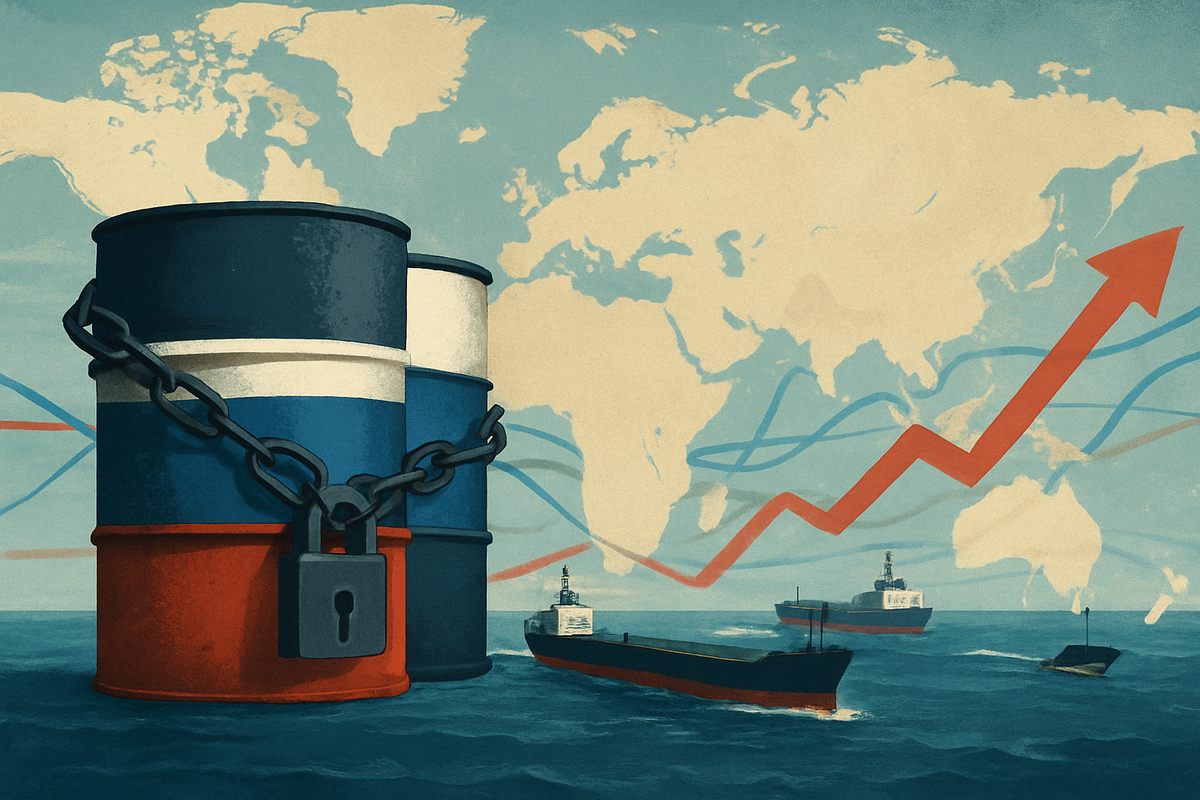
As of November 3, 2025, the Atlantic Basin oil market is facing a significant squeeze, driven by an intensified wave of sanctions against Russia's energy sector. Recent actions by the United States, United Kingdom, and the European Union, particularly targeting Russia's largest oil companies, Rosneft and Lukoil, are creating a complex environment marked by tighter crude supply, increased demand for alternative sources, and heightened price volatility. This escalation is fundamentally reshaping global oil flows and presenting both immediate challenges and long-term strategic shifts for the energy industry.
The immediate implication is a paradoxical situation: despite a global "floating glut" of approximately 1.4 billion barrels of oil, the Atlantic Basin is experiencing a shortage of readily deliverable crude. Much of this global surplus consists of sanctioned or slow-moving Russian barrels, which are increasingly difficult to integrate into the supply chains of refineries in the Atlantic Basin. This scarcity is driving up demand for non-Russian crudes and is reflected in rising oil prices and increased market uncertainty.
Escalating Sanctions and Market Repercussions
The current tightening of the Atlantic Basin oil market stems directly from a series of assertive and comprehensive sanctions packages. In late October 2025, the United States and the United Kingdom imposed extensive blocking and asset-freezing sanctions on Rosneft and Lukoil, Russia's two largest oil producers, along with their global subsidiaries. These restrictions are set to become fully effective by November 21, 2025, marking a substantial escalation in direct sanctions on Russia's energy sector. The European Union followed suit on October 23, 2025, with its own package, including a full transaction ban on Rosneft and Gazprom Neft, and a prohibition on the purchase, import, or transfer of Russian liquefied natural gas (LNG) starting January 2026.
These measures intensify pressure on major buyers of Russian crude, such as India and China. The UK has introduced a ban on imports of oil products refined in third countries from Russian-origin crude, with the EU implementing a similar measure in January 2026. The explicit threat of secondary sanctions targeting entities that continue to buy Russian crude from sanctioned companies serves as a powerful deterrent. This has led Chinese state oil companies to reportedly suspend new seaborne Russian oil purchases, and Indian refiners are reviewing their contracts and exploring options from the Middle East and Africa.
The immediate market reaction has been swift. Oil prices, particularly Brent crude, saw immediate increases of around 5% following the sanction announcements. WTI crude has moved above $60 per barrel, and Brent crude reached peaks above $67, indicating significant market uncertainty and increased price swings. This is further exacerbated by the fact that Ukrainian drone strikes on Russian refineries have also reduced Russia's refining capacity by an estimated 20% and limited its crude export capabilities, further tightening global supply. American refiners are operating at full capacity to meet export demand for refined products, contributing to a drawdown of crude stocks at Cushing, while OPEC+ has paused its scheduled production hike cycle through March 2026, adding a mildly bullish factor to oil prices.
Winners and Losers in a Reconfigured Market
The recalibration of the Atlantic Basin oil market due to Russia sanctions creates a clear delineation of winners and losers among public companies.
On the winning side, Middle Eastern producers are poised for significant gains. Companies like Saudi Aramco (Tadawul: 2222) and other national oil companies in the region are expected to benefit as Indian and Chinese refiners, previously reliant on discounted Russian crude, pivot towards Middle Eastern varieties such as Iraqi Basrah Medium and Abu Dhabi’s Upper Zakum. This increased demand will likely boost their sales volumes and potentially allow for higher pricing. Similarly, U.S. shale operators such as ExxonMobil (NYSE: XOM) and Chevron (NYSE: CVX), along with smaller independent producers, may accelerate production to capitalize on higher global oil prices and increased demand for non-Russian crude. West African and Canadian producers, including companies with significant West African assets like TotalEnergies (NYSE: TTE), and Canadian heavy oil producers such as Suncor Energy (NYSE: SU) or Canadian Natural Resources (NYSE: CNQ), could also gain market share. Integrated oil majors with strong trading arms and diverse portfolios like Shell plc (NYSE: SHEL), BP plc (NYSE: BP), and TotalEnergies (NYSE: TTE) are well-positioned to leverage their global operations, refining capabilities, and sophisticated trading desks to navigate disruptions and optimize supply chains.
Conversely, the primary losers are the directly sanctioned Russian entities and companies heavily reliant on Russian oil. Rosneft (LSE: ROSN, trading restricted), Lukoil (LSE: LUKOY, trading restricted), and Gazprom Neft (part of Gazprom, LSE: OGZPY, trading restricted) are directly targeted by US, UK, and EU sanctions. Their assets are frozen, and most transactions are prohibited, severely impacting their ability to export, receive payments, and fund operations, leading to significant revenue losses. Furthermore, Indian and Chinese state oil companies that had significant exposure to Russian crude, such as PetroChina (NYSE: PTR), Sinopec (NYSE: SNP), and CNOOC (NYSE: CEO), as well as India's Reliance Industries Ltd (NSE: RELIANCE), now face immense pressure from secondary sanctions. They are being forced to re-evaluate and reorganize their supply chains, leading to higher input costs and logistical complexities. Nayara Energy Limited, an Indian company partially owned by Rosneft, is also under significant threat. Lastly, certain shipping and insurance companies involved in the transport and insurance of Russian crude, particularly those operating within the "shadow fleet" or facilitating transactions above the G7 price cap, face increased scrutiny and the risk of being sanctioned.
Broader Implications and Historical Parallels
The tightening of the Atlantic Basin oil market due to Russia sanctions extends far beyond immediate price fluctuations and company profits, ushering in broader industry trends and significant geopolitical ripple effects. The sanctions, coupled with Ukrainian drone strikes, have reduced Russian oil output and exports, directly benefiting US and European competitors through higher refining margins. This has also intensified the shift in global oil flows, with Russian oil increasingly redirected to Asian markets. However, the latest US sanctions are now pressing these key Asian buyers to seek alternatives, leading to increased US crude imports into India and Chinese state-owned oil companies suspending new seaborne Russian oil purchases. This re-routing of trade creates inefficiencies, with more oil "in motion" via a "shadow fleet" of aging vessels, posing environmental and safety risks.
The ripple effects are felt across the global energy landscape. OPEC+ dynamics are directly influenced, with the group agreeing to pause production hikes from January-March 2026, partly due to concerns over Russia's ability to meet its quotas. This benefits non-Russian producers, as demand shifts towards their crude. However, it presents challenges for third countries like China, India, and Turkey, which now face increased pressure and potential secondary sanctions, forcing them to diversify their energy sources at potentially higher costs. The EU's 19th sanctions package, adopted in October 2025, further solidifies its energy security strategy by prohibiting Russian LNG imports from January 2027 and targeting entities in third countries assisting Russian oil exports.
From a regulatory and policy perspective, the direct targeting of Rosneft and Lukoil represents a significant escalation, moving beyond the G7 oil price cap. While the US leads with the most restrictive measures, enforcement remains a critical challenge, with the G7 price cap facing significant issues due to alternative trading and payment structures. These sanctions are fundamentally reshaping the global energy architecture, potentially accelerating trends towards regional supply chains and alternative payment systems that bypass traditional Western financial infrastructure.
Historically, sanctions on Iran's oil sector and Venezuela's PDVSA offer parallels. Iranian sanctions significantly reduced its oil production and exports, while US sanctions on Venezuela in 2019 led to a dramatic decline in its output. These precedents demonstrate that while sanctions can severely impact oil markets, they also spur evasion strategies and a reorientation of trade. Russia's deeper integration into the global economy before the sanctions, and the sheer scale of its oil production, make its detachment a more profound challenge for the global market to absorb disruptions compared to Iran or Venezuela.
The Road Ahead: Navigating Uncertainty
The Atlantic Basin oil market is set for continued volatility and re-alignment in the short and long term. In the immediate future, the market will grapple with the full implementation of sanctions on Rosneft and Lukoil by November 21, 2025, which risks curtailing an estimated 500,000 to 600,000 barrels per day of Russian output. This will sustain supply tightness in the Atlantic Basin, even as a global "floating glut" of sanctioned oil persists. Indian and Chinese refiners will continue their pivot away from Russian crude, increasing demand for Middle Eastern and Atlantic Basin grades, which could lead to higher import costs for these nations. OPEC+'s cautious approach, pausing production increases in Q1 2026, aims to stabilize the market amidst these disruptions.
Looking further ahead, the global energy map is likely to undergo a fundamental reconfiguration. A more fragmented market with distinct trading blocs—one aligned with Western sanctions and another accommodating Russian crude—is a strong possibility. This fragmentation could lead to increased inefficiencies but also accelerate the energy transition as nations prioritize security of supply over cost optimization. Investment may see a resurgence in non-sanctioned oil and gas regions, though tempered by long-term decarbonization goals. Despite immediate tightness, the market faces a structural oversupply risk from relentless US production (projected to average 13.7 million bpd in Q4 2025) and OPEC+'s expanded quotas.
Strategic pivots are already underway. Countries like India and China are actively diversifying their crude sources. Russia, in turn, is adapting by relying on a "shadow fleet" of older tankers and non-Western financial systems, complicating safety oversight and increasing environmental risks. Western powers are continuously adjusting and tightening sanctions to target loopholes and intermediaries, utilizing advanced monitoring technologies. Opportunities lie in expanded market share for non-sanctioned producers, accelerated investment in renewable energy, and the development of new trade routes and infrastructure. However, challenges include persistent price volatility, complex supply chain disruptions, and the ongoing geopolitical risks in key shipping lanes.
Potential scenarios include effective sanctions enforcement leading to sharper supply reductions and price spikes, forcing Asian buyers to permanently shift away from Russian oil. Alternatively, successful Russian circumvention through its "shadow fleet" might mitigate immediate supply disruptions but come at the cost of deeper discounts for Russian crude. The response of OPEC+ and non-OPEC+ supply will also be crucial; a misstep could lead to uncontrolled price surges or significant market oversupply.
Conclusion: A New Era for Global Oil
The escalating sanctions against Russia, particularly the recent measures targeting Rosneft and Lukoil, have irrevocably altered the Atlantic Basin oil market. As of November 3, 2025, the key takeaways are clear: a significant tightening of readily available crude in the Atlantic Basin, increased price volatility, and a forced re-routing of global oil trade flows. Major non-Russian producers and integrated oil majors are poised to gain, while sanctioned Russian entities and their traditional buyers face severe operational and financial challenges.
Moving forward, the market will remain tight and susceptible to geopolitical developments. The shift in crude flows, with Indian and Chinese refiners seeking alternatives to Russian oil, will drive demand for Middle Eastern and Atlantic Basin crudes, potentially increasing freight rates for compliant tankers. While new production from Canada, Norway, Iraq, and Guyana is slated for late 2025 and early 2026, which could ease prices, the overarching theme is one of fragmentation and re-evaluation.
The lasting impact of these sanctions will be a permanent alteration of global energy geopolitics, accelerating trends towards regional supply chains, alternative payment systems, and de-dollarization in energy markets. This new landscape will be characterized by increased market inefficiencies and long-term supply chain restructuring. The sustained pressure on Russia's energy sector, especially through technology transfer restrictions, could permanently constrain its ability to maintain and develop production capacity.
Investors should closely monitor several factors in the coming months: the effectiveness of sanction enforcement and compliance by third countries, particularly India and China; OPEC+'s decisions regarding output; global and regional inventory levels; and broader geopolitical developments, including U.S.-China trade discussions and the ongoing Russia-Ukraine conflict. The resilience of Russia's economic adaptation and the evolution of shipping and freight rates will also be critical indicators. In essence, the Atlantic Basin oil market is navigating a complex and evolving landscape where geopolitical considerations, supply chain reconfigurations, and the effectiveness of sanctions will continue to dictate price movements and trade flows. Investors must remain vigilant and adaptable to these dynamic conditions.
This content is intended for informational purposes only and is not financial advice




